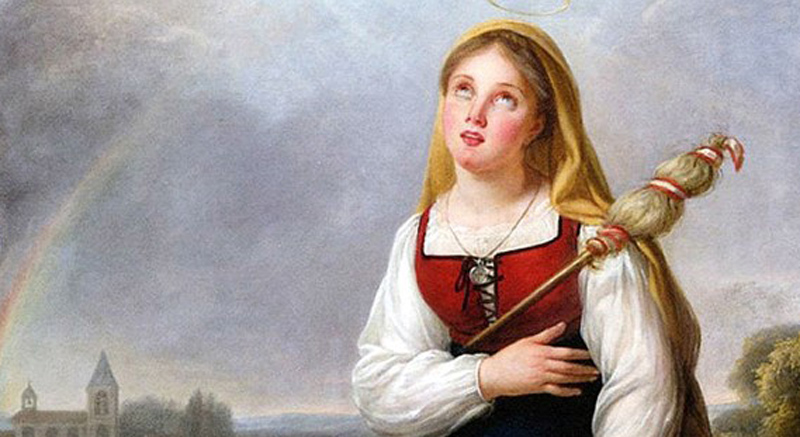(422-512 AD)
Genevieve, the patron of the city of Paris, was born in the small town of Nanterre, about four miles from Paris.
She was noticed when only 7 years old by St. Germanus, who happened to be in Nanterre on his way to Britain. After preaching to the townsfolk, he addressed her parents, predicting their daughter’s future sanctity. He said that she would serve God, and that others would imitate her example.
He then asked Genevieve whether she desired to serve God in a state of perpetual virginity, and to bear no other title than that of a spouse of Jesus Christ. The child answered that this was what she had long desired and begged that by his blessing she might be from that moment consecrated to God.
The holy prelate went to the church of the place, followed by the people, and during long singing of psalms and prayers, he held his hand upon the virgin’s head. After dismissing her he charged her parents to bring her again to him early the next morning.
The father complied with the request, and St. Germanus asked Genevieve whether she remembered the promise she had made to God. She said she did, and declared she would, by the divine assistance, faithfully perform it. The bishop gave her a brass medal, on which a cross was engraved, to wear always about her neck, to put her in mind of the consecration she had made of herself to God; and at the same time, he commanded her never to wear bracelets, or necklaces of pearls, gold or silver, or any other ornaments of vanity. She religiously followed those instructions, considering herself as the spouse of Christ. She fervently practiced devotion and penance.
At about 15 years of age, Genevieve was presented to the bishop of Paris to receive the religious veil. The bishop recognized her previous promise to St. Germanus and granted her wish.
She lived a spartan life only eating twice weekly and prayed constantly. After the death of her parents, she settled with her grandmother in Paris, leaving occasionally for charitable work in other cities of France. She was not only known for her charity but became known for her remarkable predictions as well.
Many people were skeptical of her prophetic powers. In fact, they persecuted her as a false visionary, hypocrite, and the like, all tending to disparage her innocence. The arrival of St. Germanus at Paris, probably on his second journey to Britain, for some time silenced her accusers; but it was not long before the accusations broke out anew. Her enemies were fully determined to drown her, when the Archdeacon of Auxerre arrived with blessed bread, sent her by St. Germanus, as a testimony of his particular esteem for her virtues, and a token of communion. This seems to have happened whilst St. Germanus was absent in Italy in 449, a little before his death. This circumstance and its critical timing converted the prejudices of her doubters into veneration for her during the remainder of her life.
It was a turbulent time. Christianity was not universally observed. Childeric, the king of the Franks in his quest for territory placed a blockade on the city of Paris. Genevieve organized the procurement of several boat loads of provisions to the citizens from towns upriver. When Childeric, still not a Christian, finally became lord of Paris he maintained a great respect for the Saint and on several occasions bowed to her intercession on the part of prisoners of the crown.
When Atilla the Hun was on a path toward Paris, Genevieve urged her compatriots to trust in the Lord. She spent many days in prayer with other women in the baptistry of the Church of Paris. When the invaders took an unexpected turn, avoiding the city and heading toward Orleans, the people of Paris gave new respect to Genevieve and the power of prayer.
St. Genevieve has been credited with the first design of a church dedicated to Sts. Peter and Paul, built by King Clovis with the encouragement of his wife St. Clotilda. Neither Genevieve, nor the king would live to see the completion of the building dying within weeks of each other. Also buried near each other, the faithful built a wooden oratory over the tomb of the saint. Her relics were later enclosed in a beautiful shrine of silver and gold, made by St. Eligius himself in 630. The church was plundered and restored several times through history but reverence for Genevieve and miracles attributed to her intercession led to the original Church of Saints Peter and Paul being known exclusively as St. Genevieve.
The most famous miracle associated with St. Genevieve took place in 1129, during the reign of Louis VI. A pestilential fever, with a violent inward heat, and pains in the bowels, swept the city, in a short time, killing fourteen thousand people. The physicians of the day were unable to supply any relief. Stephen, bishop of Paris, with the clergy and people, asked for divine mercy, by fasting and supplications. The plague did not to abate until the shrine of St. Genevieve was carried in a solemn procession to the cathedral. During that ceremony, many sick people were cured by touching the shrine, and of all that then lay ill in the whole town, only three died. The rest recovered, and no others fell ill. Pope Innocent II coming to Paris the following year, after having passed a careful scrutiny on the miracle, ordered an annual festival in commemoration of it on the 26th of November, which is still kept at Paris.
Adapted by A. J. Valentini from: St. Genevieve, Virgin Chief Patroness of the City of Paris | EWTN. (n.d.). EWTN Global Catholic Television Network. Retrieved December 30, 2020, from https://www.ewtn.com/catholicism/library/st-genevieve-virgin-chief-patroness-of-the-city-of-paris-5504
